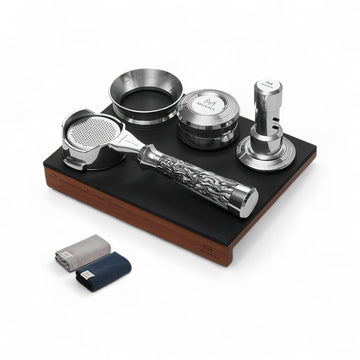Would Espresso still be itself if we did not call it that? Would Turkish coffee by any other name smell as tremendous? How are the differences between Espresso and Turkish coffee? Well, the last one is a simple question but it is still a debate because of a variety of preferences. Now, let’s dive deeper into the distinction between Turkish coffee and Espresso to understand why.
What is Espresso?
Coffee experiences a long process to make from the plant to the shot. Espresso requires more finely ground coffee that a coffee maker forces. The coffee will have a rich and intense flavor.
Espresso is one of the coffee’s oldest rehearsal methods, having finely-ground darker roast coffee that a coffee machine makes steam through. The coffee will be rich and strong in flavor.
We usually use an Espresso coffee maker to create the coffee today. The quality determines how good or bad your cups are. A high-quality device will prepare more excellent Espresso from any freshly ground beans you pick.
What is Turkish coffee?
Turkish coffee has a little different coffee preparation method. Coffee beans are finely-ground and roasted. Though Turkish coffee needs roasted coffee beans to make the final results like Espresso, it will be harder to grind finer coffee.
You will need to use the equipment to support you or buy prepackaged. When you get the coffee grounds, you could mix them with cold water and sugar in a small pot, known as the Cezve. Then, you need to boil them on the stove.
Differences between Espresso and Turkish coffee
The debate between Espresso and Turkish coffee seems to be subjective. Which one is better? You should spend time trying both, incredibly one right after the other, to get the most excellent comparison. Many of you think that Espresso and Turkish coffee have hundreds of similarities. Nonetheless, there are differences between these drinks.
Overall flavor
Both Turkish coffee and Espresso have rich flavors; however, you will be amazed that Turkish coffee flavor is more robust than Espresso. Each type of bean provides unique profiles.
Turkish coffee gives us a three-step drinking experience, beginning with the froth at the top and moving to a smooth section, and finishing with a gritty region (because of settled grounds).
Espresso, on the other hand, inherits several flavor nuances that Turkish coffee lacks. Espresso provides us with a coffee cup that is vibrant and has a plethora of origin notes while Turkish coffee gives us a strong cup of coffee with an ample body.
Cultural significance
Turkish coffee and Espresso keep special points in cultures, customs, and traditions. Turkish coffee is part of the local culture while Espresso looks like an enjoyable drink. UNESCO recognizes the Turkish Coffees Intangible Cultural Heritage of Humanity. Both Turkish coffee and Espresso often have special positions in various cultures.
Turkish coffee: a friendly and generosity symbol
In Middle Eastern nations (especially Turkey), serving Turkish coffee to guests is a friendly gesture of the host. The complex brewing process indicates that the host’s dedication offers significant experience for their visitors.
Sharing a cup of Turkish coffee possibly improves conversations and moments among friends and family members. Apart from a social lubricant, Turkish coffee has become a culture and art in Middle Eastern regions.
Turkish coffee plays a vital role in traditional marriage proposals where the grooms serve coffee cups to their husbands and families, filled with various levels of sweetness.
Espresso: a unique way of showing Italian’s lifestyle
Turkish coffee is relished as a leisure activity while Espresso has become a common way of rushing urban lifestyle in Italy. In general, Italians enjoy their cups when standing at bar counters before turning to their busy days, supporting them to consume intense flavors without spending much time in a drink.
The act of drinking Espresso has developed into a necessary daily habit for locals, who take several shots throughout the day, from morning to evening. The popularity of Espresso in Italy is a chance for evolving coffee bars and cultural importance.
Brewing process
Turkish coffee brewing takes longer than Espresso once you have accurate equipment. A good device possibly makes Espresso in a minute and half, but the time will be increased if you would like to brew more than a shot.
Turkish coffee often requires a few minutes to boil on the stove, with an extra preparation if you would like to add more sugar. This drink demands you to begin with cold water when mixing coffee grounds and sugar. Nevertheless, this is a westernized process.
In Turkey, people usually use a big and sand-filled pan set in an open fire. The process may help the heat do well. When the process is done correctly, the coffee will move to the top. From there, you should pour some of the coffee out and put it back on the sand to heat up again.
Espresso, on the other hand, allows many of you to use already-hot-water in a coffee maker, making the brewing process faster. You do not have to spend time waiting for the coffee to boil. The difference is no more than a couple minutes, but if the time is so tight, Espresso is incredibly quicker.
Roasting selection
Dark roast coffee beans are the best option of Espresso. Turkish coffee works well in any roasting beans. A correct Espresso roast often takes a little longer and a little hotter than other coffee beans, reducing acidity and enhancing the overall flavor.
Turkish coffee does not demand special roasting coffee beans. Thus, you can try a medium roast as the coffee beans will burn a little more during boiling. Or starting with light roast beans is also a good idea. When using a light roast for your first shot, you will identify the flavor. Then, you can use a darker cup to find your true flavors.
Grinding process
Espresso requires the finest grind size popularly known. Nonetheless, the grind used for Turkish coffee is possibly finer. 200 micrometres thick is Turkish coffee while 400 micrometres thick is Espresso. These are outstanding enough to steam through coffee grounds and make the authentic beverage without leaving big gaps that you would see in a coarse grind.
Caffeine intakes
There are lots of factors to take into account when figuring caffeine content between the styles. Darker roasts always provide less caffeine than other coffee bean roasts. Therefore, the propensity in Espresso use ought to alleviate potency. However, Espresso is stronger in the 2 styles.
Espresso has about 63 milligrams of caffeine (per fluid ounce). This is the standard shot size for Espresso and it is slightly higher than regular coffee (per ounce). Turkish coffee inherits around 25 milligrams of caffeine (per fluid ounce).
Water immersion techniques
A main difference between Turkish coffee and Espresso is how water combines with the coffee grounds. Espresso is a pressure-based method, heating water to high temperatures and rapidly moving it through dense beans. Meanwhile, Turkish coffee is a boiling rehearsal method, combining coffee grounds with water in a heated pot.
Taste
Turkish coffee has a thick foam due to the boiling process. Furthermore, it has a rich and dark flavor. Someone adds spices in the shot such as turmeric, cloves, and cardamom. Because the spice is not filtered, you will get a full bunch of texture throughout the cup. Espresso gives you a different way to enjoy it. Letting your cup cool a little bit and sipping it. You probably drink your Espresso cup in 3 sips and rest apart to feel different flavors and textures in each sip.
Coffee cups
Serving Turkish coffee in a small cup which is called a fincan. It has conventional decorations on the side. Beyond keeping high heat, these cups also keep the right amount of water (120ml). Espresso is often served in a thick wall cup. The top of the cup is small so that the crema occurs thicker.
Health effects
Since Turkish coffee offers much more caffeine than Espresso, consuming a lot can cause restlessness, headaches, insomnia, and anxiety. Moreover, Turkish coffee increases blood pressure and heart rate. If you are sensitive to high caffeine, then you could enjoy Espresso.
Preparation
Turkish coffee takes a long time to prepare and the whole process could be 10 minutes. This is because you should wait for the coffee, remove it from heat, and reheat it many times. Espresso requires only 30 seconds to brew when the hot water flows through the coffee ground under pressure.
Serving style
Turkish coffee is served in small cups, often combined with a glass of water and a sweet treat (sometimes) like Turkish delight. In other words, you should enjoy the coffee in a small sip. So, you can feel the flavor and savor the experience.
With Espresso, you need to enjoy it in small shots. Because Espresso is a quick beverage, you might consume it instantly. General speaking, Espresso shots are often relished as a standalone drink or combined with other coffee creations.
Roasting process
For the Espresso, the roasting preparation is long as the grains must be dark and well-toasted. This peculiarity balances acidity and makes the mixture more intense and potent. For Turkish coffee, most people will roast the beans based on their preferences. Coffee lovers in Turkey prefer dark roasted beans. They often recommend medium to dark roast beans with various techniques.
Benefits of Turkish coffee
In addition to its rich history, Turkish coffee provides many benefits.
- Antioxidants: Turkish coffee contains several antioxidants that helps your body prevent free radicals. These antioxidants avoid cell damage and decrease inflammation, which might reduce the risks of chronic diseases.
- Brain function: drinking Turkish coffee probably enhances brain function thanks to caffeine content. Caffeine arouses the central nervous system and boost alertness, concentration, and mood.
- Good compounds to reduce cholesterol levels (cafestol and kahweol): Turkish coffee is unfiltered, meaning that it contains splendid compounds like cafestol and kahweol. These minimize cholesterol levels.
Benefits of Espresso
Espresso is not only a beverage but also a real experience. Although coffee has a small amount of caffeine, it still contains multiple benefits.
- Antioxidants and risk of chronic diseases decline: Espresso is a well-known beverage of antioxidants. Many compounds can protect against cell damage caused by free radicals in your body. With legitimate consumption, Espresso boosts overall health and decreases the danger of chronic diseases.
- Cognitive function: aside from antioxidant elements, Espresso contains rich caffeine intake, which offers a natural energy boost. Enjoying a moderate amount of caffeine has been connected to cognitive function and athletic performance.
- Athletic performance: Espresso contains an amount of caffeine, so they inherit a natural energy boost. Drinking a moderate amount of caffeine improves cognitive function as well as physical performance.
- Weight loss: science experts discover that drinking Espresso could be beneficial for weight loss. This is because they can boost metabolism and improve appetite simultaneously.
Key takeaway
Espresso and Turkish coffee might seem akin at first sight but they have many differences when you take an in-depth understanding. The differences are usual but simpler to tell than you think. Turkish coffee and Espresso have always been main rivals. Even if both commenced closeness, each drink has its own unique points. If you love strong coffee, both are fantastic options to engage. After that, you experience how distinctive they are.













